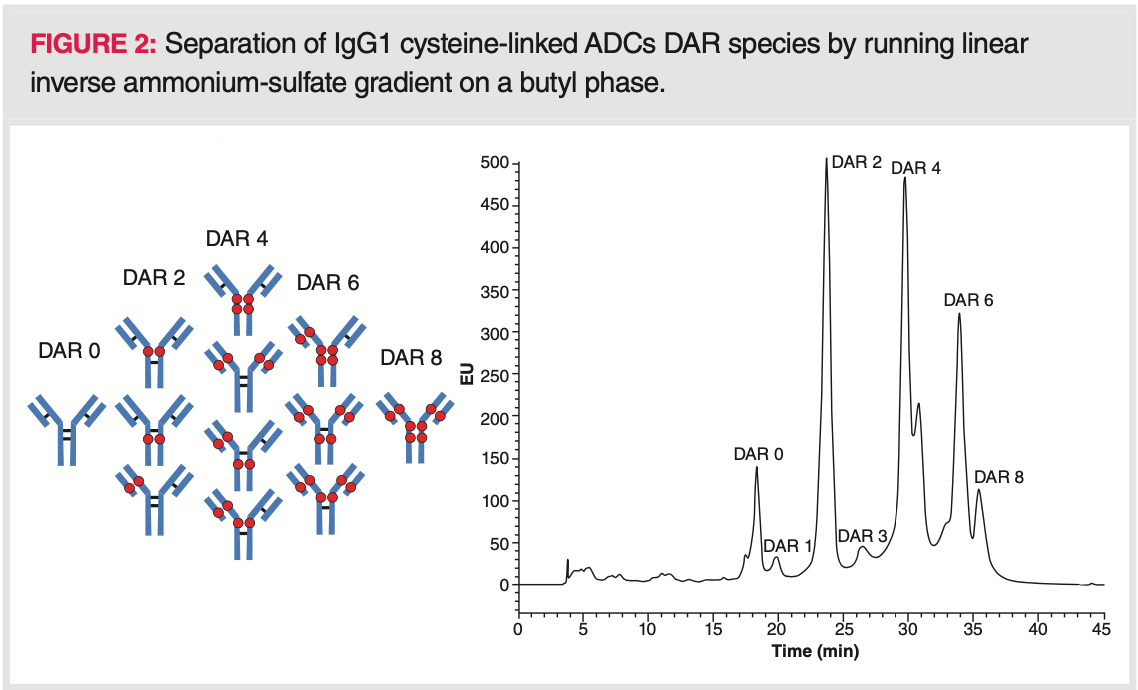New Gas Chromatography (GC) Products for 2020–2021
“GC Connections” presents the column’s annual review of new developments in the field of gas chromatography (GC) seen at Pittcon and other venues in the past 12 months.
I am pleased to present our annual review of new products in gas chromatography, introduced between spring 2020 and spring 2021. Many of these products were showcased at the virtual 72nd meeting of the Pittsburgh Conference on Analytical Chemistry and Applied Spectroscopy (Pittcon), USA, from March 8–12, 2021. While the interface and events at the virtual conference were presented well, with easy navigation and tonnes of content at the fingertips, the interaction was not nearly as rich as an in‐person meeting.
Pittcon 2022 was held from March 5–9, 2022 in Atlanta, Georgia, USA. I strongly encourage all readers to consider attending a gas chromatography (GC)‐related conference or participate in your local or regional chromatography discussion group in the next year. I have used the rise of the virtual conferences to attend meetings that I would not have attended otherwise due to the travel costs, but I will still attend my usual set of in‐person meetings when they come back. The past year of 2020–2021 has been a rough period for conference organizers and for the many vendors, contractors, and economies that conferences support. They need your help. Conference and meeting attendance is still the most effective and efficient way to train and educate yourself about GC and improve your skills and performance.
The exposition included virtual vendor booths virtually displaying new instrumentation and products. Most booths included video content and links to instrument brochures, application notes, and other technical literature. Vendor personnel were on hand to chat or video conference with attendees. The interface was presented to look a lot like the actual conference booths, which was a nice touch. One plus was that the basic navigation for all the booths was the same, whether a large or small vendor was displaying. This seemed to somewhat level the playing field for user attention.
The virtual technical programme at Pittcon 2021, which ran over five days from Monday through Friday included a very strong GC presence. Pittcon continues to be a leading showcase for the latest GC, gas chromatography–mass spectrometry (GC–MS), and two‐dimensional gas chromatography (GC×GC)‐related research. While none of the major awards were presented to gas chromatographers this year, the technical programme included numerous oral presentations and posters presenting new GC‐related techniques and applications.
There were several symposia, oral sessions, poster sessions, and networking events with significant GC presence, enough to keep attendees very busy on all days. Overall, sessions related to cannabis analysis, biofuels, food and beverages, forensics, pharmaceuticals, and general applications of both GC and GC×GC were offered. GC itself is trending toward being less the driver of session topics than its applications to scientific problems. Searching the Pittcon technical programme website using “GC” as the keyword shows relatively few sessions with GC in the title, but many GC talks and posters. The Pittcon 2021 virtual conference website content is available on demand until June 2021, effectively extending the conference. Readers are encouraged to take advantage.
The information presented in this article is based on vendors’ responses to questionnaires and additional information from press releases, websites, and product literature, not on actual use or experience of the author. Every effort has been made to collect accurate information but because of the preliminary nature of some of the material, LCGC Europe cannot be responsible for errors or omissions. This column cannot be considered a complete record of all new GC products introduced in the past year because not all vendors chose to respond to the questionnaire, not all had a strong presence at Pittcon, nor is all the submitted information necessarily included here, because of the limited available space and the editors’ judgment as to its suitability. Table 1 provides a listing of the vendors highlighted in this review. For a more complete picture of the GC‐space today, I encourage you to review the two previous years’ reviews (1,2).
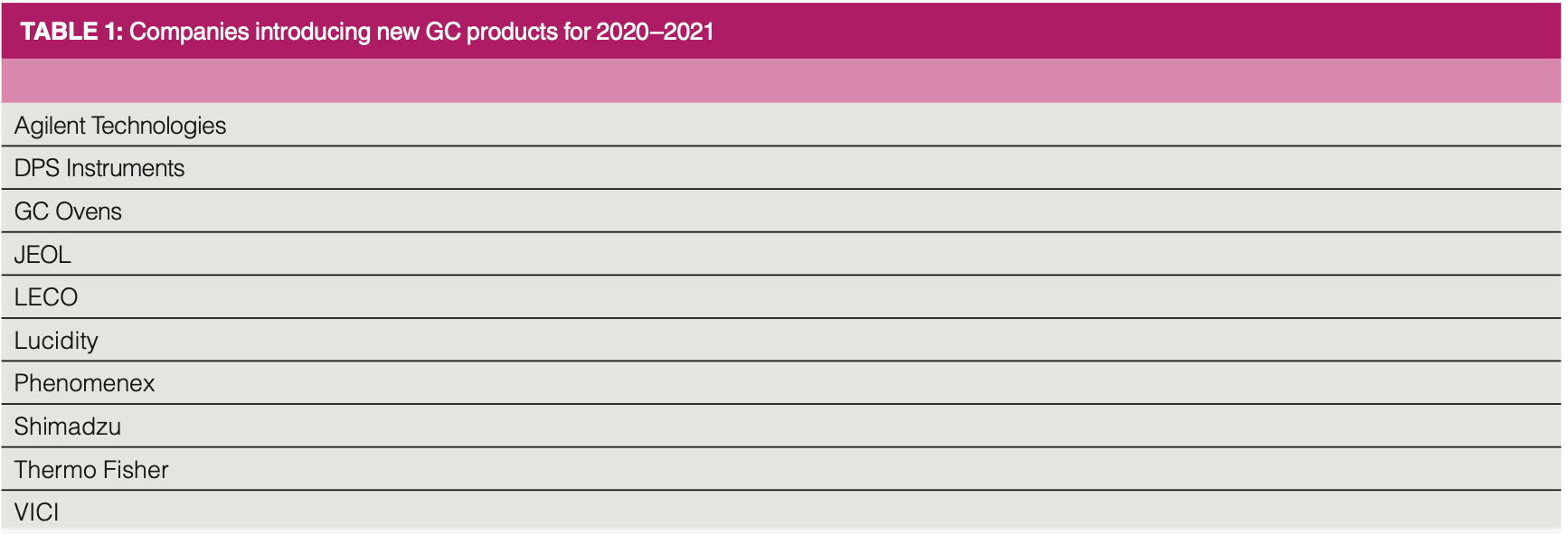
In new instruments, trends seen over the past few years toward smaller, more automated systems that are more specialized, and spectrometric detectors continue with the product introductions at Pittcon 2021. Table 2 shows a list of new instruments introduced over the past year, including a miniature GC system, several all‐in‐one systems, and several new GC‐MS systems featuring new mass spectrometers.
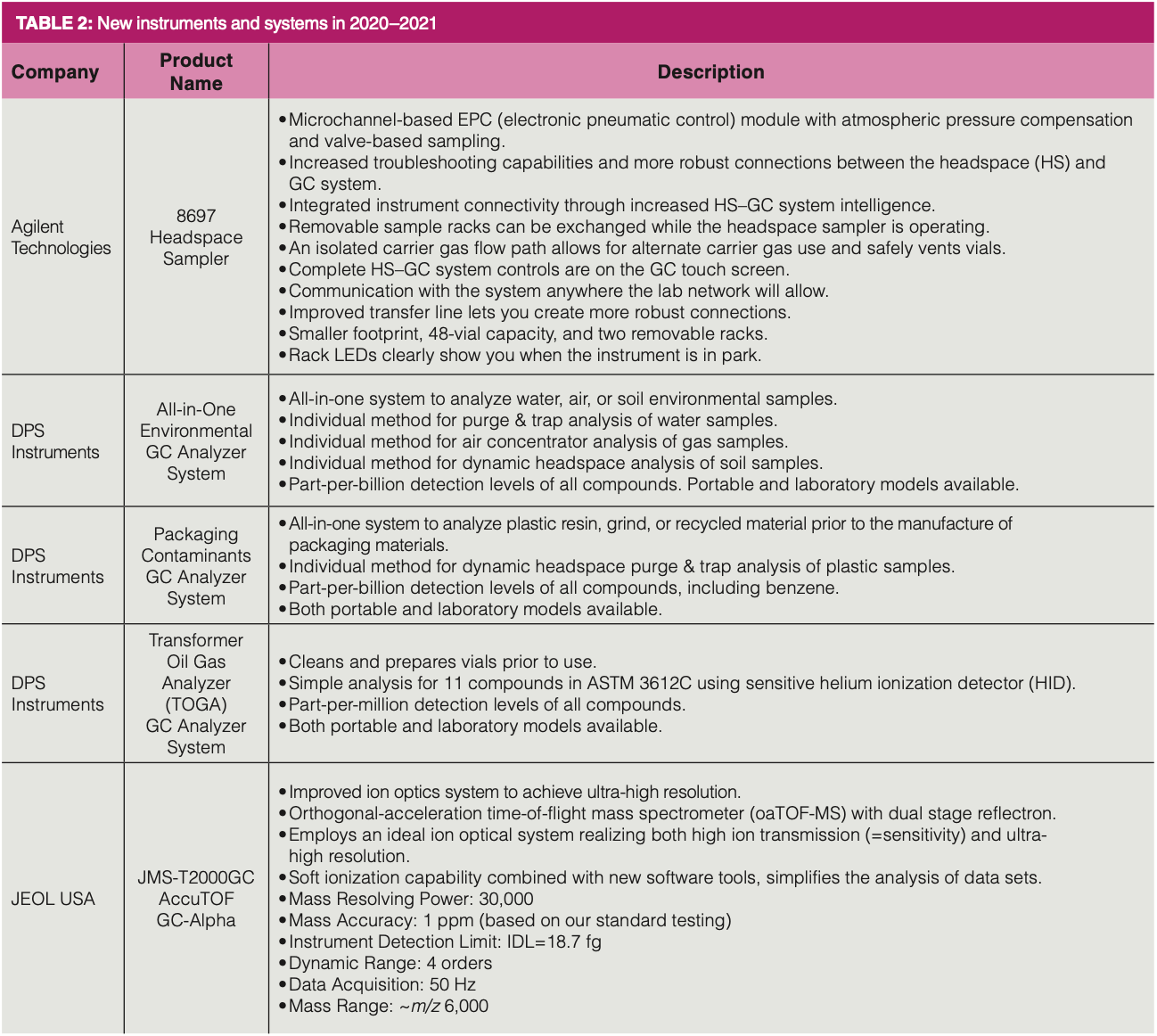
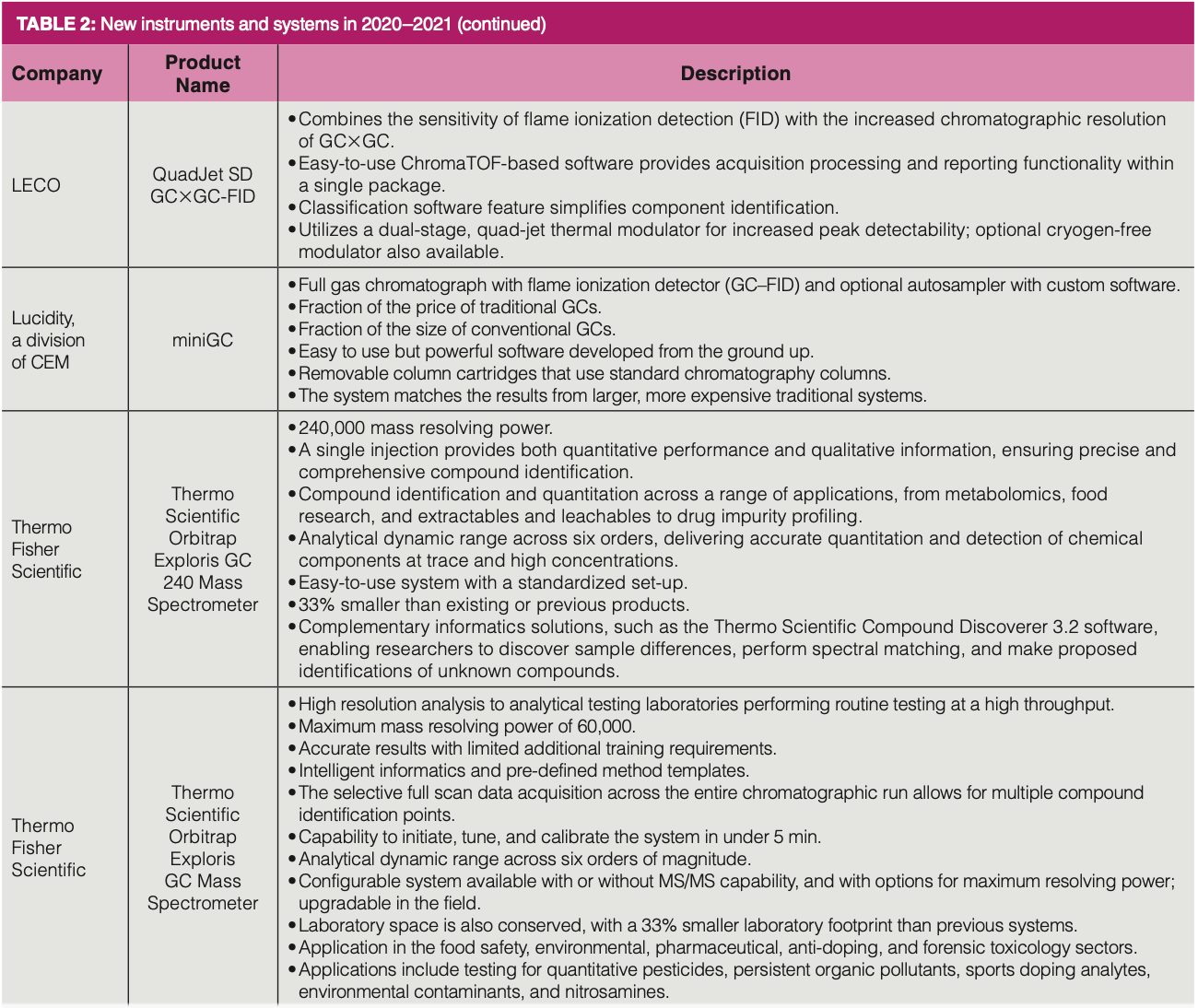
Capillary column stationary phases continue to be updated by most of the vendors, with nearly all making incremental improvements or showing new applications in their online application note libraries. The two new stationary phases highlighted in Table 3 provide examples of an important and ongoing trend in capillary column development: new stationary phase chemistries for specific problems. Both stationary phases are examples of classical stationary phase chemistries that have been modified to suit specific problems—in these cases, separations of fatty acid methyl esters and dioxins.
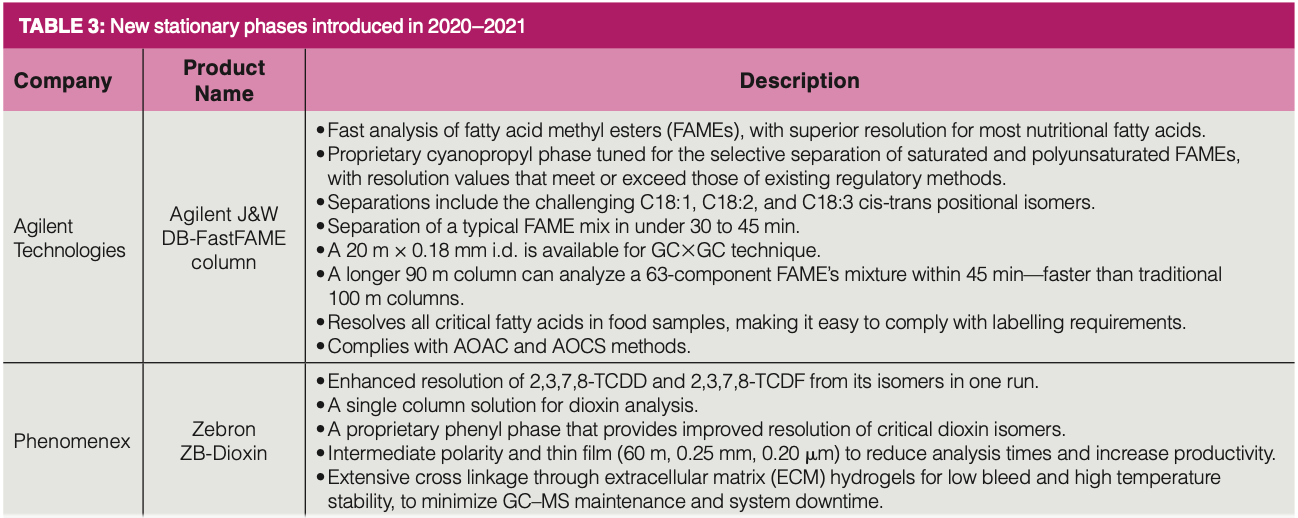
Developments in new accessories and consumables continue to trend toward simplifying analysis, and making chromatographers’ work easier. Both accessories and consumables are also developing to improve inertness in the sample flow path. Sample preparation is not covered broadly here. For more information on sample preparation, see the specific sample preparation article by Douglas Raynie in the upcoming May issue of LCGC Europe. As with the GC reviews, it is worthwhile to review the past two years as well for a complete picture of sample preparation products (3,4). Table 4 provides a listing of products displayed at Pittcon 2020.
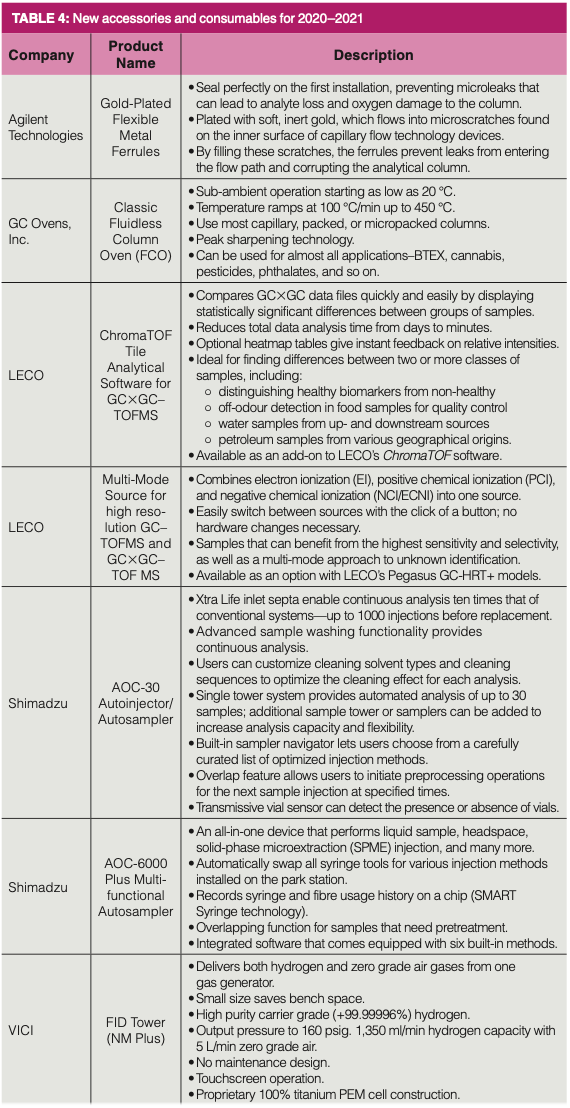
I encourage readers to continue your education and training. Besides several short courses associated with Pittcon, additional training and educational resources are available for 2021. The pandemic has resulted in much growth in online training and seminar offerings by vendors and training organizations. Opportunities for in‐person short courses, seminars, and training are beginning to start up again and are offered by most major instrument vendors and through many conferences and organizations, including the American Chemical Society, Eastern Analytical Symposium (Princeton, New Jersey, USA, November 2021) and local and regional chromatography discussion groups. LCGC Europe’s online training system, CHROMacademy, launched a completely revamped online platform in 2020, and is hosting a virtual symposium in May, 2021. I will be offering online short courses on Advanced GC for the Chromatography Forum of the Delaware Valley (www.cfdv.org) on June 15, 2021, and for the Eastern Analytical Symposium (www.eas.org) in early July.
As GC approaches 70 years since its conception, development and invention are still going strong. As seen at Pittcon 2021, GC‐related developments and innovations are ongoing and include all areas: sampling and supplies, new instruments, columns, detectors, data systems, and educational opportunities. I look forward to more innovation and advancements throughout the 2020s, and I hope to see many of you at EAS 2021 in my home state of New Jersey or at Pittcon 2022 in Atlanta, USA.
References
1) N.H. Snow, LCGC Europe 33(5), 248–256 (2020).
2) J.V. Hinshaw, LCGC Europe 32(5), 250–257 (2019).
3) D.E. Raynie, LCGC Europe 33(5) 241–247 (2020).
4) D.E. Raynie, LCGC Europe 32(5), 258–263 (2019).
COLUMN EDITOR
Nicholas H. Snow is the Founding Endowed Professor in the Department of Chemistry and Biochemistry at Seton Hall University, USA, and an Adjunct Professor of Medical Science. During his 30 years as a chromatographer, he has published more than 70 refereed articles and book chapters and has given more than 200 presentations and short courses. He is interested in the fundamentals and applications of separation science, especially gas chromatography, sampling, and sample preparation for chemical analysis. His research group is very active, with ongoing projects using GC, GC–MS, two-dimensional GC, and extraction methods including headspace, liquid–liquid extraction, and solid-phase microextraction. Direct correspondence to: amatheson@mjhlifesciences.com
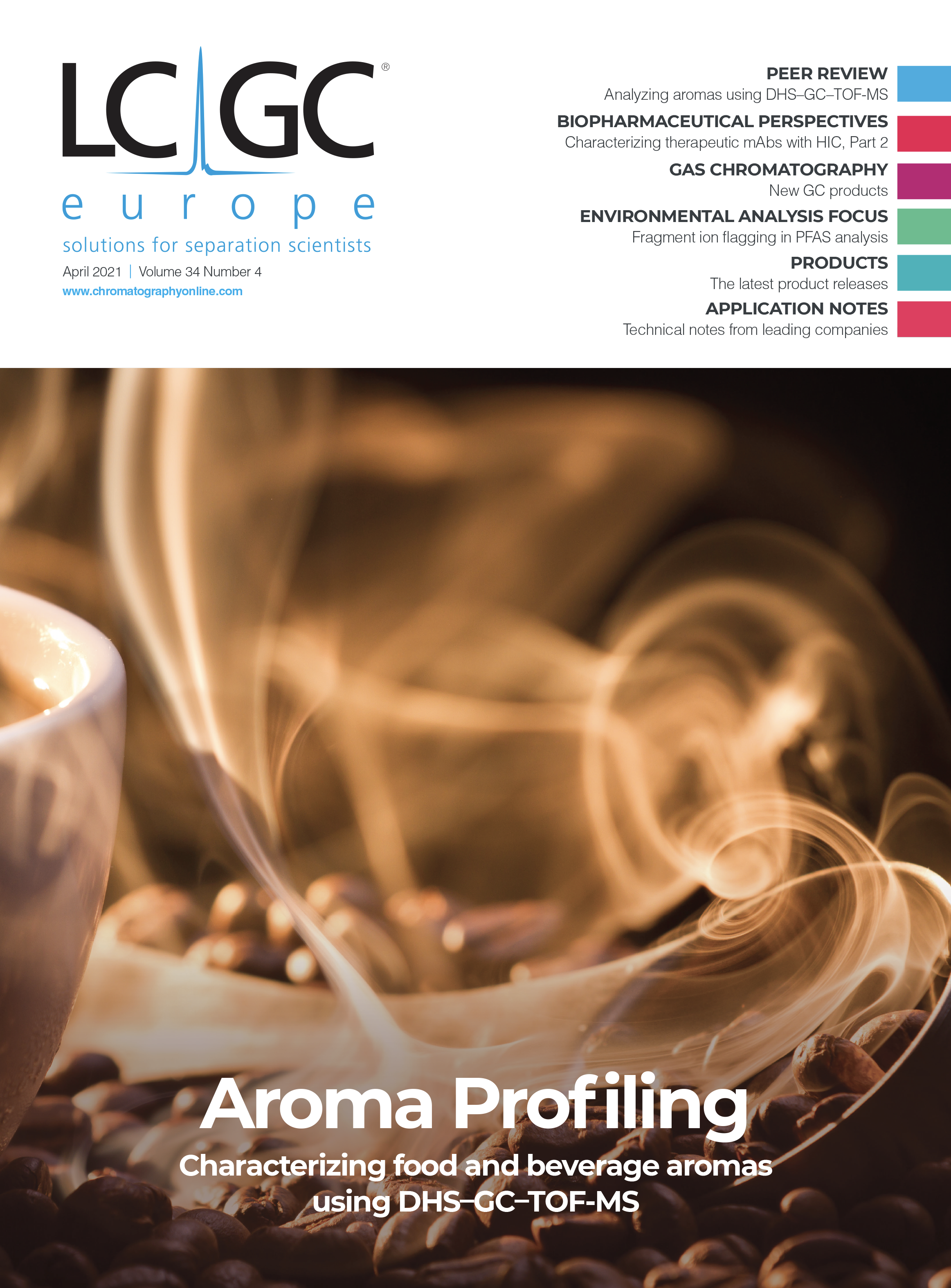
University of Rouen-Normandy Scientists Explore Eco-Friendly Sampling Approach for GC-HRMS
April 17th 2025Root exudates—substances secreted by living plant roots—are challenging to sample, as they are typically extracted using artificial devices and can vary widely in both quantity and composition across plant species.
Miniaturized GC–MS Method for BVOC Analysis of Spanish Trees
April 16th 2025University of Valladolid scientists used a miniaturized method for analyzing biogenic volatile organic compounds (BVOCs) emitted by tree species, using headspace solid-phase microextraction coupled with gas chromatography and quadrupole time-of-flight mass spectrometry (HS-SPME-GC–QTOF-MS) has been developed.
Fundamentals of Benchtop GC–MS Data Analysis and Terminology
April 5th 2025In this installment, we will review the fundamental terminology and data analysis principles in benchtop GC–MS. We will compare the three modes of analysis—full scan, extracted ion chromatograms, and selected ion monitoring—and see how each is used for quantitative and quantitative analysis.

.png&w=3840&q=75)

.png&w=3840&q=75)



.png&w=3840&q=75)



.png&w=3840&q=75)


